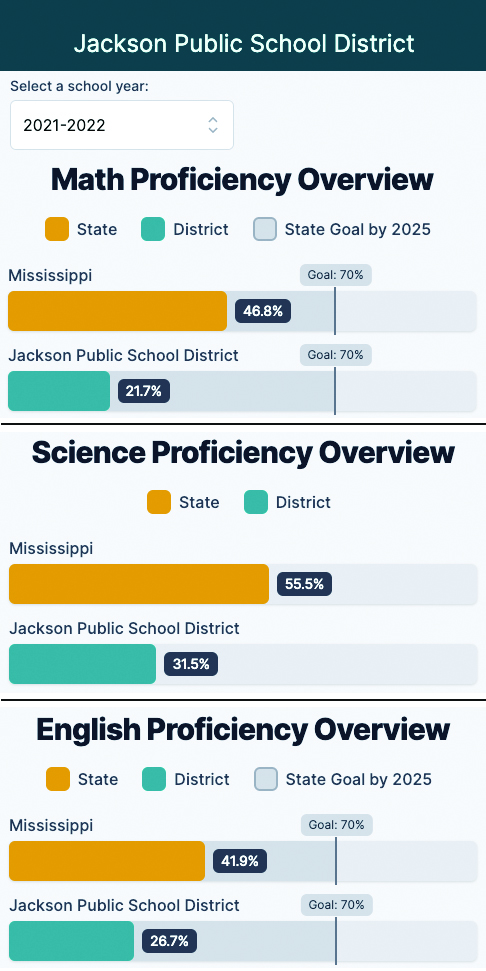After reviewing data published by the Mississippi Department of Education, it is crystal clear that there is so much data that for average persons it is like a maze, leaving them left wondering what is the true status of the public education.
The data can mean one thing if it only compares one Jackson public school to another or to the Jackson Public School District (JPS) as a whole. It can mean quite another thing if it compares JPS to the state’s system as a whole. It can paint quite different pictures when the state is compared to the country as a whole, and the country to other nations around the globe.
We can begin by noting that for the 2021-2022 school year the district as a whole was rated C. This certainly is good news considering that in recent years JPS had been rated D and F, both of which meant that the district was open to being raided by charter school proponents, or even risking state control.
Looking closer at the data, one finds that in terms of individual schools, there were ten A-rated schools – Bailey APAC Middle, Casey Elementary, Johns Hopkins Elementary, Key Elementary, Lake Elementary, Lester Elementary, McWillie Elementary, Northwest Middle, Obama Elementary, and Power APAC Elementary.
There were eight B-rated schools – Callaway High, Dawson Elementary, Galloway Elementary, Lee Elementary, Pecan Park Elementary, Peeples Middle, Spann Elementary, and Timberlawn Elementary.
There were 13 C-rated schools – Baker Elementary, Clausell Elementary, Forest Hill High, Isable Elementary, Jim Hill High, Johnson Elementary, McLeod Elementary, Murrah High, North Jackson Elementary, Smith Elementary, Van Winkle Elementary, Walton Elementary, and Wilkins Elementary.
There were 12 D-rated schools – Bates Elementary, Boyd Elementary, Chastain Middle, Green Elementary, Kirksey Middle, Lanier High, Oak Forest Elementary, Provine High, Raines Elementary, Sykes Elementary, Whitten Middle, and Wingfield High.
And, there were five F-rated schools – Blackburn Middle, Brinkley Middle, Cardozo Middle, Marshall Elementary, and Powell Middle.
This is quite an improvement from the previous score card. Nevertheless, a very important question remains, i.e., exactly what elements are responsible for the assignment of the letter-grades A, B, C, D, and F? Reportedly, it is not merely a matter of student performance on standardized scores. An explanation is needed so that supporters can help the schools secure and maintain the very best ratings.
The data also shows that in the key areas of Math, English, U.S. History, and Science proficiency, the JPS results, as compared to the state results, are disappointing.
However, there are hopeful signs in other areas. For example, the JPS high school graduation rate is 84.6%, compared to the state rate of 88.4%, and 48.9 % of the JPS graduates enroll in post-secondary institutions.
Furthermore, when the state released its report card, national news was made as Mississippi moved from near the bottom (49th) to 21st in Reading and 33rd in Math. Even more dramatically, children from low wealth families saw their growth rank rise to being 3rd in Math and 2nd in Reading. There were celebrations all-around.
Unfortunately, the celebrations were marred by the suspension of seven Jackson Public School principals whose schools were being investigated for testing irregularities. The schools involved – Dawson, Lanier, Lester, Marshall, McLeod, Peeples, and Wilkins – have since had 44 staff members penalized for the infractions. Hopefully, that will be the end of the fall-out. The students should not be made to suffer psychologically nor in terms of funding for their school. It should be only the guilty parties who are punished and that the rest of the schools’ families are able to move-on, helping to improve the teaching-learning process.
As one examines the data, it appears that had the state legislature fully funded the Mississippi Adequate Education Program (MAEP), schools in Jackson and across the state would likely have scored higher and been rated much more favorably. Such funding could have helped to improve facilities, to secure more and better equipment and materials, and to hire and retain more teachers. Reportedly, since the MAEP funding in 2009, JPS has operated without a deserved $185,984,623 and the public schools across the state have lost $3,522,120,115 in unappropriated MAEP funds.
In the future, as school and student achievements are analyzed, it would be a gigantic step forward if the gap was closed between the “reported” achievement of the predominately Black and predominately white school districts and schools. Currently, it is unclear whether the differences result from funding, bias, and other factors. Whatever is the case, it needs to be effectively addressed immediately.
Finally, it would be helpful if Mississippi joined the ranks of the schools across the country that routinely participate in and accept national academic assessment measures. After all, Mississippi’s children study and graduate to compete with others across the country and need to be prepared to do so successfully and assessed to assure that it is happening.
The data assembled by the state tells part of the story. As educators, parents, and others concerned about public education, there is much more that needs to be known. Interested and responsible parties must continue to step-up and ask the important questions, prompting better actions and outcomes.







